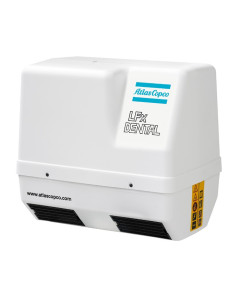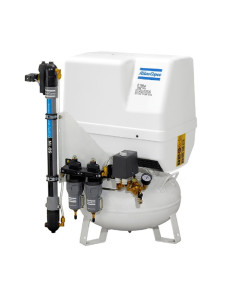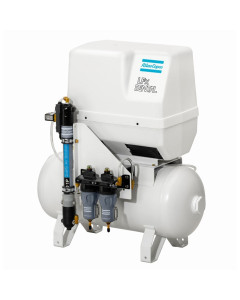Medical Compressors: Pneumatic Technology for Healthcare Environments
Medical compressors represent a specialized category of pneumatic equipment specifically designed to meet the demanding needs of the healthcare sector. These devices differ from conventional industrial air compressors due to their strict purity standards, quiet operation, and exceptional reliability—essential characteristics in clinical environments where compressed air quality can directly affect patient outcomes.
Distinctive Features of Medical Compressors
Medical compressors are characterized by specific technologies that ensure their suitability for healthcare applications:
- Oil-free air: Similar to oil-free Atlas Copco compressors, these units eliminate the risk of lubricant contamination, which is fundamental for medical applications where air purity is critical.
- Reduced noise levels: They operate at significantly lower sound levels (generally below 60 dBA) to maintain a quiet environment for patients and staff.
- Advanced filtration: They incorporate multi-stage filter systems that remove bacteria, viruses, and microscopic particles.
- Stable pressure: They maintain constant pressure levels to ensure precise operation of sensitive medical equipment.
- Redundancy and reliability: Designed with backup systems to ensure uninterrupted supply in critical situations.
Key Takeaways: Essential Characteristics
- Oil-free technology for maximum air purity.
- Quiet operation adapted to healthcare environments.
- Advanced filtration systems for medical-grade air.
- Redundant design to ensure continuous operation.
Primary Applications in the Healthcare Sector
Medical compressors are fundamental components in numerous healthcare applications:
- Respirators and ventilators: They supply precise, clean compressed air for life support equipment.
- Surgical equipment: They power pneumatic tools used in surgical procedures.
- Anesthesia systems: They provide compressed air for precise administration of medical gases.
- Clinical laboratories: They drive analysis and diagnostic equipment that requires compressed air.
- Dentistry: They power handpieces and other pneumatic dental instruments.
- Respiratory therapy: They supply air for nebulizers and respiratory therapy equipment.
Available Technologies and Configurations
Depending on specific requirements, medical compressors come in various configurations:
- Medical piston compressors: Similar to industrial piston compressors but with specific adaptations for medical use, they offer excellent performance for lower-volume applications.
- Medical screw compressors: Based on screw compressor technology, they provide continuous operation with lower noise, ideal for hospital facilities.
- Medical scroll compressors: They use spiral compressor technology to achieve oil-free air with high efficiency and minimal maintenance.
- Centralized systems: Complete installations that include redundant compressors, dehumidifiers, filters, and pressure tanks to supply an entire medical facility.
Specific Regulations and Certifications
Medical compressors must comply with strict international and national regulations:
- ISO 7396-1: International standard for medical gas supply systems.
- ISO 13485: Quality management system for medical devices.
- United States Pharmacopeia (USP): Establishes quality requirements for medical air.
- FDA regulations: U.S. Food and Drug Administration requirements for medical devices.
- NFPA 99: National Fire Protection Association standards for healthcare facilities in the USA.
Selection Criteria for Medical Compressors
When choosing a medical compressor, it's essential to consider:
- Capacity and demand: Calculate the air consumption of all connected equipment, considering simultaneity and reserve factors.
- Required air quality: Determine the level of purity needed according to the specific application.
- Redundancy: Evaluate the need for backup systems for critical applications.
- Sound level: Consider the installation environment and acceptable noise limits.
- Maintenance: Assess maintenance requirements and availability of spare parts.
- Energy efficiency: Analyze long-term energy consumption, especially in 24/7 operations.
Key Takeaways: Medical Compressor Selection
- Correctly size according to air demand and safety factor.
- Verify compliance with specific healthcare sector regulations.
- Consider redundancy for critical applications.
- Evaluate total cost of ownership, including energy efficiency.
Maintenance and Operational Considerations
Maintenance of medical compressors is particularly critical due to their application in healthcare environments:
- Rigorous preventive maintenance: Strictly following intervals recommended by the manufacturer.
- Continuous monitoring: Supervision systems that alert about deviations in critical parameters.
- Regular filter replacement: Using specific air filter cartridges and service filter kits for medical applications.
- Air quality testing: Periodic analysis to verify compliance with medical standards.
- Condensate management: Appropriate condensate drainage and separation systems to prevent bacterial contamination.
Recent Innovations in Medical Compressors
The medical compressor sector has experienced significant advances in recent years:
- Inverter technology: Similar to VSD screw compressors, it allows adjusting air production to actual demand, improving energy efficiency.
- Remote monitoring: IoT systems that enable remote supervision and predictive maintenance.
- More compact and quieter designs: Adapted to limited clinical spaces and noise-sensitive environments.
- Integrated treatment systems: Incorporating refrigerated dryers and advanced filtration in compact solutions.




Login and Registration Form